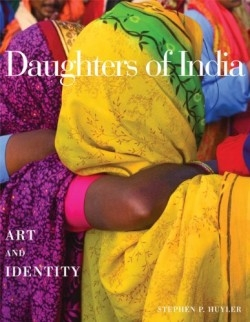Daughters of India
Art and Identity
- 2008 INDIES Winner
- Gold, Women's Issues (Adult Nonfiction)
India has long captured the Western imagination. The increased attention given to the world’s most populous democracy and rising economic power has done much to inform outsiders that the subcontinent is about more than abject poverty or meditating gurus. Cultural anthropologist Stephen Huyler, however, asserts that little is yet known outside India about its women, as much of Western re-portage is “misinformed or misguided, depicting all or most of them as victims.” Huyler seeks to correct these misperceptions by profiling, through text and photography, twenty women from diverse backgrounds and communities, representing the breadth of modern Indian society and the challenges they face.
Ranging in age from six to eighty, and in economic circumstances from slums to wealth, from dwellers of tiny rural villages to the world’s largest city, the profiled women also represent most of India’s major religions and geographical areas. Their commonalities are creative expression through art and a determination to improve their lives and those of their children.
First up is Pushpa, a widow who supports her children with meager wages earned as a sweeper at the Mumbai airport. After decades of struggle, living sometimes in the open air and then under plastic sheeting, she finally secured a tiny concrete home on the edge of the airport. The pressures of modernization and globalization have Indian government officials announcing plans to bulldoze slums like the one Pushpa calls home. Plans to move the slum-dwellers to north of Mumbai would place Pushpa too far from work and without the re-sources to build another house. The future seems bleak for her and her deaf son, but Pushpa refuses to succumb to despair: “I am worried about my son and his inability to support his family; and now as I get older, I may lose my job and my home. My belief teaches me to live in the present and I try to do that. Who knows what the future will bring?”
Pushpa takes great care to beautify her tiny home, which she built with her children, honoring special guests by drawing a sacred design in rice flour, called kolam, at its entrance. The ritual of kolam is practiced by women in diverse circumstances throughout India, and Huyler provides many fabulous photographs of this everyday art, painstakingly created then swept away by wind, rain, or trampling feet. Rice flour is a readily-available and common means of creative expression for India’s women, with techniques and designs passed from mother to daughter. The women captured by Huyler’s camera work in other media as well, including paint and embroidery.
Seemingly worlds away from Pushpa, Achamma’s life consists of e-mails, cell phones, and material luxury. Yet this successful IT entrepreneur also struggles to balance family and economics, and finds joy in creating traditional art with beautiful flowers arranged in concentric circles outside her apartment door to celebrate her daughter’s sixteenth birthday.
Achamma started a business when a large plantation in the state of Kerala asked her to develop some software for them. She bought her first PC in 1986, and after two decades her business was worth $30 million. India’s Business World labeled her the “poster girl of Kerala’s IT success…and of its entrepreneurial spirit.” Her success has not come without stress or challenges. In 2004, her original company was underwritten by a group of Mumbai investors who eventually bought her out. “I embodied the threat of a woman trying to succeed in business at a high level in a male business world,” she said. “I was forced out under pressure from the jealousy of male egos….All my effort in creating a world-class product has created bitter ri-vals.”
Huyler’s interest in India began when he first visited during his college years. He became fascinated with the art of kolam dur-ing this initial trip, photographing designs and writing an illustrated paper for his undergraduate degree at the University of Denver. In 1994, he published Painted Prayers: Women’s Art in Village India, which became part of a popular museum exhibition that trav-eled the world.
Huyler has provided a fascinating glimpse into the lives of women who shape their culture, as well as the culture which reciprocally shapes them. This volume should appeal to anyone with an interest in India or women’s issues, but the stories and pictures are compelling enough to engage even the most casual reader.
Reviewed by
Sharon Flesher
Disclosure: This article is not an endorsement, but a review. The publisher of this book provided free copies of the book to have their book reviewed by a professional reviewer. No fee was paid by the publisher for this review. Foreword Reviews only recommends books that we love. Foreword Magazine, Inc. is disclosing this in accordance with the Federal Trade Commission’s 16 CFR, Part 255.

